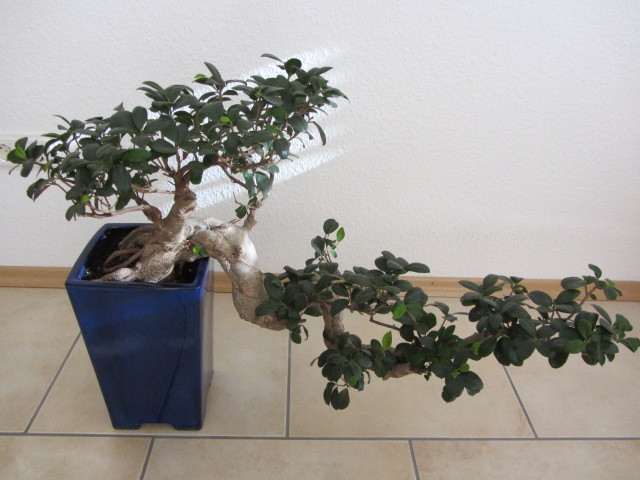Question
 Colegrove Question Fic
Colegrove Question Fic
Hello -- Next fall I'd like to move a small ficus tree from Germany to Colorado. I'm confident of moving it safely, with a special transportation box I'll make, and plant will be inside the box for about 18 hours, in a pressurized, but likely cool section of the aircraft. However, before I undertake the preparation I'd like to know the odds of being successful - meaning the tree would survive the move, and transition to Colorado without a large die-off of branches. Here's the specifics:
- Not sure which Ficus variant, picture attached
- Pot size 8" square, by 12" deep
- Currently Lotsa indirect, and occasional direct light daily (South facing room, large windows)
- New location (CO) will be very similar in available light - South facing room, large windows (I could measure the light environment here if that's important to do ?)
- High humidity here (70% RH), low humidity in CO (30% RH), but could mist daily until move stress is over.
- Tree has been in this room location for 3 years w/o any problems
Thanx (in advance) for your advice !!
/Greg
AnswerHi Greg,
Your bonsaied Ficus is commonly called Ficus Ginseng bonsai and is also known as Banyan Fig bonsai and Taiwan Ficus bonsai. Its botanical name is Ficus retusa. It is a close relative of Ficus benjamina and its care is the same.
If it is possible for you to carry the boxed plant with you in the plane cabin, that would be the optimum solution. Once you give it to airline personnel, you lose control over just what happens to it. That said, I think your Ficus will survive under normal care, although it may shed some leaves.
Temperature is the primary concern. If temps fall below 50 degrees F., it will suffer leaf drop quite quickly. If temps drop close to or below freezing, then you could lose the plant. Temperature in the cargo hold of the plane at high altitudes and also on the ground in the process of loading are where temps are a concern. Discuss this with your airline.
A day or two without light should not be a problem, although the more you can minimize the dark period, the better. Water it a day or two before the move so the soil is moist, but not wet during transit.
Proper packing is very important, of course. Assume that the container will get inverted at some point. Make sure newspaper is taped tight around the soil so that it stays in place if tipped upside down. Insulating material will help keep it warm if you anticipate that being a problem.
Ficus species are notorious for dropping leaves when they are relocated. This is primarily a reaction to a change in light. The better you can duplicate the light in your new environment, the easier the transition will be. However, as long as there is adequate light, your Ficus will make the transition eventually by producing new foliage that is adapted to the new location.
Ficus trees are not very sensitive to dry air. They do quite well in heated environments where RH is often below 15% in winter. Misting will not be necessary and actually does very little in terms of raising RH, anyway.
In sum, as long as you can avoid cold temps and can insure proper physical protection while it is in transit, your tree should do just fine.
I have written articles on Ficus care and bonsai trees that I will email for free to you (or anyone else) who sends a request to me at wcreed@HorticulturalHelp.com.
Please let me know if any of this is unclear or if you have any additional questions.
If this information has been helpful, please click the Rate Volunteer bar below and enter a rating and nomination for me. I am a volunteer on this site so Ratings are the only compensation I receive for answering plant questions.
Need more information? Visit my website at:
A link to HorticulturalHelp.com
or email me at wcreed@HorticulturalHelp.com or call me at 917-887-8601 (EST)
Regards,
Will Creed, Interior Landscaper
Horticultural Help, NYC
Visit my website at: A link to HorticulturalHelp.com






